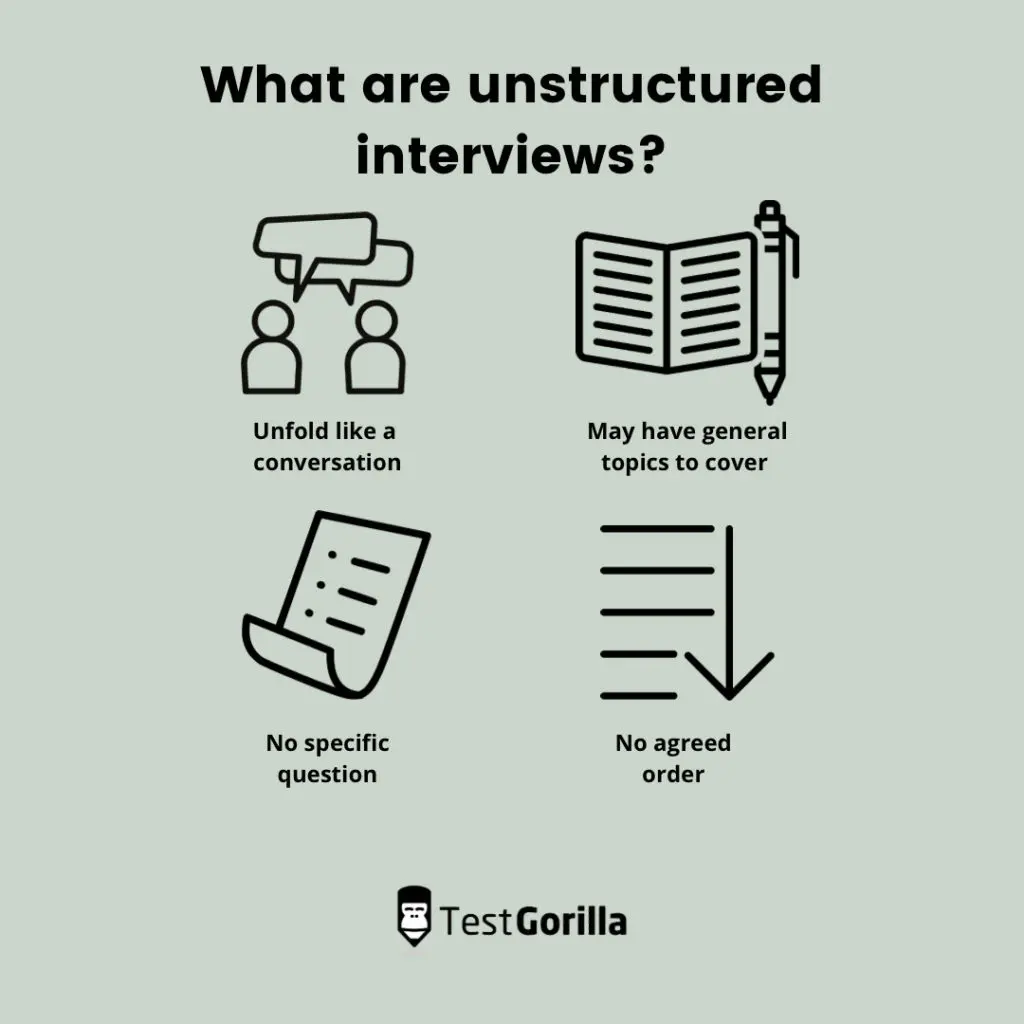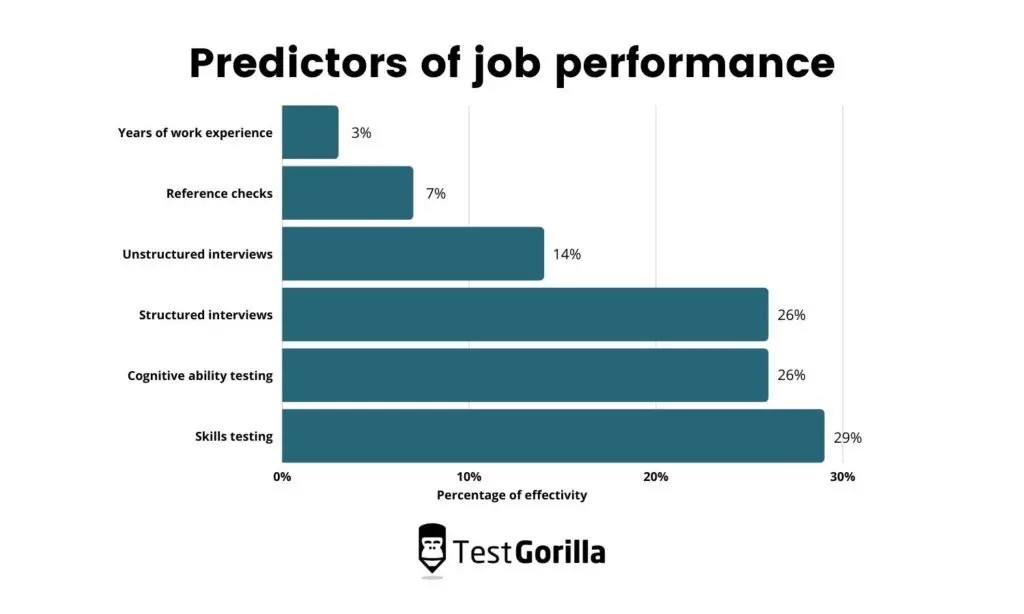We all like to think that we’re unbiased when it comes to hiring.
But when you break it down, a lot of hiring decisions are actually based on criteria that aren’t at all related to how well a candidate will do in the job.
In fact, studies show that 39% of interviewees get rejected based on their confidence level, their tone, or whether they smiled in their interview.
You might not even realize you’re being biased – but short of committing to blind hiring, how can you solve this issue?
Changing the way you interview can help.
In this article, we’ll compare unstructured and structured interviews.
We’ll also explain how switching to a structured approach can help eliminate bias and make your hiring process quicker and easier.
Table of contents
What are unstructured interviews?
Unstructured interviews are pretty much what they say on the tin.
You let the interview unfold like a conversation, and though you might have general topics you want to cover, you don’t have a specific set of questions written down or any agreed order in which to ask them.
This means that candidates are most likely to be asked questions that:
Are different every time
Are in a different order each time
Are not necessarily related to the core competencies of the role
Are not judged with a standardized assessment
Don’t have clear benchmarks for good answers
Imagine you’re interviewing someone for a social media manager role. You spend a bit of time talking about their past experience, go on a tangent about Facebook ads and the algorithm, then forget to ask them what experience they have with influencer marketing (which is the very thing you want them to pioneer).
This would be a typical unstructured interview – there’s a little hit and miss in the earlier stages, but there are scenarios in which it might be useful.
For example, if you have an experienced HR rep who can keep the interview on track, an unstructured approach might be okay.
One of the advantages of unstructured interviews comes up in the later stages of the hiring process.
By this point, you usually have a good idea of whether the candidate could perform the job at hand. You’re mostly looking for rich qualitative data that can only be gleaned through natural conversation: how they come across in discussion and gel with your senior leadership.
What are structured interviews?
In structured interviews, on the other hand, interviewers have a set of questions that have been designed in advance and focus on the core competencies of the role you’re hiring for.
You know what you’re looking for from each question, and you ask each one in the same order each time. You can go off-script if you want to, but you will always return to it.
Let’s take the social-media manager example. Here are some questions you can use to help you find what you’re looking for in a social-media manager:
Are you comfortable with Facebook Business Manager?
What’s your experience with influencer marketing strategies?
How would you best leverage Instagram to connect with customers?
How do you feel about Instagram sponsored posts versus organic posts?
You can also ask follow-up questions when appropriate, such as if they have a particularly interesting idea. However, you can trust that the questions on your list will lead you to the right conclusion.
There are two main types of questions in structured interviews: behavioral and situational.
Let’s dig into them for a moment.
Behavioral interviews
Behavioral interviews, as you might guess from their name, focus on past behavior.
However, they involve more than just recapping what a candidate has written on their CV: They’re an opportunity to dig into how the candidate has responded to challenges in their working life.
In the social media manager example we gave earlier, your list of questions might include:
Tell us about a time when you failed to reach a target. How did you handle it?
Can you give us an example of a campaign that wasn’t working? What did you do to rectify it?
Tell us about a time when you misunderstood an important task. How did you handle that situation?
The candidate’s answers will give you a deep insight into their capabilities based on real situations.
The other type of structured interview is the situational type.
Situational interviews
Whereas behavioral questions ask candidates how they have reacted to past work dilemmas, situational interview questions propose hypothetical scenarios and ask your candidate to describe how they would react if they were to happen.
Think of it as the difference between asking an interviewee to describe a time they had to fix a mistake they made at work and giving them an example of a mistake they might make on the job at your company and asking them how they’d react.
The advantage of including situational questions in structured interviews is that you can discuss the optimal answers with your team in advance and use their answers as a benchmark.
Here is a sample list of questions you might use in a situational interview:
What would you do if you made a mistake in your work but no one else on your team noticed?
How would you respond if a client asked you to allocate extra time to their project without speaking to your supervisor first?
How would you go about measuring the performance of our company?
In this case, the candidates’ responses will give you an idea of how they react under pressure, their creativity, and their ability to think on their feet.
Example of a structured interview in action
Here is an example video interview to give you a better idea of what a structured interview looks like – start with the section between 1:06 and 2:16.
What’s the difference?
The difference between these two styles is pretty obvious if you’ve been paying attention, namely, whether or not you have prepared a list of questions in advance and stick to an exact order.
However, there is slightly more to it than that. Here’s a breakdown of the key differences between structured interviews and unstructured interviews and the benefits of each.
Structured Interview | Unstructured Interview | |
Preparation required | Agree on questions to ask based on the core competencies of the role; Agree on the order the questions should be asked in; Set benchmarks with decision-makers for what “good” looks like | Minimal – an understanding of the job specification and key hiring practices |
Questions asked | Fixed – related to the core competencies of the role | Up to the interviewer – not necessarily directly related to the role |
Question order | Fixed | Freestyle |
Question types | Behavioral (exploring past experiences and how candidates have behaved in business situations); Situational (describing hypothetical scenarios they could encounter in their role) | Open ended, up to the discretion of the interviewer |
Best suited for | Quantitative or empirical data gathering early on in the hiring process | Qualitative understanding of the candidate in the very late stages of hiring |
Assessment | Judged due to benchmarks and expectations set ahead of time with hiring decision-makers (for instance, using a rating scale to grade responses) | Judged subjectively by the interviewer |
Now that we’re clear on what the two types are and their differences, the natural question that comes to mind is…
Unstructured vs. structured interviews: Which is better?
Let’s cut to the chase: We believe that structured interviews are less of a hassle for your hiring team and more effective overall.
This is because unstructured interviews are not a good predictor of job performance – in fact, they’re worse than flipping a coin. That’s why Google did away with them completely because they found that they predicted just 14% of job performance.
That doesn’t sound so bad, right?
It does when you consider that reference checks are 7% effective at predicting candidates’ job performance, and looking at their years of work experience is 3% effective.
Structured interviews, on the other hand, performed much better. They predicted 26% of job performance, a number that could easily be supplemented with additional skills tests and sample work.
Finally, it turns out that work sample tests (skills testing) are the best predictors of job performance which is 29 percent effective. Meanwhile, cognitive ability testing is tied with structured interviews as the second-best predictor of job performance (also at 26 percent).
Here are some of the benefits of structured interviews and the reasons why we think you should use them in your business.
1. They reduce your overall cost per hire
We all know that the hiring process can be expensive. An SHRM study showed that the average cost per hire is slightly more than $4,000, thanks to spending on:
Fees for job boards and marketing for your job listing
Costs for running pre-interview assessments (though there are free options for candidate screening tests out there)
Any brand-building outreach your company does, for example, at college recruitment fairs
Internal costs
That last one is a big one.
Internal costs include your salary and any costs you incur in-house during the recruitment process (for instance, hiring a meeting room for interviews if you’re in a communal office building).
The more time you spend on hiring one candidate, the less value it brings to your business.
We know what you’re thinking: Surely, these costs are an argument in favor of unstructured interviews. You save time on interview prep, and all you need is the HR rep you’ve already hired.
That sounds right, but it’s not quite how that works.
Although unstructured interviews seem like less hassle up front because you don’t need to do as much prep for them, the initial preparation of a structured interview gives you the ability to make decisions much more quickly and easily once the interviews are over.
All of this means that structured interviews are much more effective than unstructured interviews. They’re easier for you when it comes to making a decision in the short term, and in the long term, there’s less chance that you’ll have to repeat the same process in six months.
You’ll avoid incurring the huge cost that comes with a bad hire, and your supervisors will thank you.
2. They’re more objective
When it comes to reducing bias in your selection of candidates for an interview, pre-interview testing is the way forward.
Once they’re in front of you, it’s time for structured interviews to take over. If you don’t believe us, ask the Harvard Business Review: They found that structured interviews were effective in removing bias from job interviews.
This is because all candidates are being asked the same questions in the same order, which gives them equal opportunity to show their skills and experience – not to mention the fact that it ensures your process is fully compliant with labor laws.
Structured interviewing techniques don’t just mitigate unconscious bias when it comes to factors such as gender.
Yep. Did you know that one Yale study found that even after completing a training course on how to hire objectively, male and female scientists still preferred to hire men?
They also help you stay on track no matter what mood you’re in or the pressure you’re under.
Imagine Candidate A comes in on a morning when you have an open schedule, and you’re feeling refreshed and energized. In an unstructured interview, you could chat with them for ages and have a lovely time, but you would not be able to dig deep into the core competency questions.
Candidate B, on the other hand, comes in on a Friday afternoon. You’re stressed because you have to finish a presentation for your boss before closing time. You’re not in the mood to goof around, so you have less fun but focus more on the key questions.
How on earth are you going to compare these two candidates?
Well, that’s where our next benefit comes in.
3. They make it easier to analyze and compare results
By asking all of your candidates the same set of questions in the same order, you can gauge their performance much more quickly and easily through direct comparison.
This is especially true when you implement a rating scale for certain answers based on the key criteria you used to write the questions.
This means no more “Oh, he was a really nice guy, but I spoke to her more about time management…”
Instead, you will be able to see at a glance that although Candidate A scored highly on having clear long-term goals and good communication skills, Candidate B had higher scores in the more critical areas for the job at hand. This will make data collection a breeze.
Congratulations, your decision just got much easier to make.
4. They reduce your time to hire
When combined with skills testing, structured interviews can be a highly effective tool in reducing your overall time to hire.
According to an interview conducted by Yello, 35% of recruiters said that evaluating candidates was the most time-consuming part of the hiring process, while 28% said it was making a final decision. However, with a structured interview and skills tests, you don’t have to spend loads of time reading CVs or picking over interview notes.
You can make quick, data-informed decisions with a high likelihood of success. Not only will this make scaling hiring easier, but if you’re in charge of hiring for a role alongside your main job, it enables you to get back to your key focus area as soon as possible.
5. They’re based on present skills, not past experience
Finally, structured interviews enable your candidates to show you what they can actually do – not just tell you what they’ve already done.
By the end of your interview process, you can be totally sure that your candidates are qualified, particularly if you already filtered them using optimized skills testing.
This leaves you free to use your expertise to find the right fit.
This isn’t just guesswork: Research shows that job experience is a poor predictor of job performance.
Instead, researchers recommend that you shift your focus to better predictors, like cognitive-ability tests, structured interviews, situational-judgment tests, and college grade point average.
So should we bid farewell to unstructured interviews?
In most scenarios, yes – the benefits we’ve covered above are overwhelming…
However, you can still rely on unstructured interviews if you:
Require qualitative data (likely in a final interview after giving a structured interview)
Want to offer a “relaxed” interview environment
Have highly experienced HR staff who know how to minimize biases
Combine it with reliable skills tests, like TestGorilla’s skills tests
Another option is to go for semi-structured interviews in place of unstructured interviews. These bridge the gap between structured and unstructured interviews – take a look:
Structured | Semi-structured | Unstructured | |
Predetermined questions | ✔ | Some | ╳ |
Predetermined order of questions | ✔ | ╳ | ╳ |
Openness to additional questions | Limited | Moderate | Complete |
Where next?
Now that you know the differences between structured and unstructured interviews and the benefits of structured interviews for your company, there’s one logical next step: Creating an unbiased structured interview process for your organization.
But do you need to go at it alone?
No, we’re here to help with our article on how to conduct a structured interview, in which we give you:
Best practices for creating structured interview questions
Top tips to use before a structured interview with candidates
An interview guide template for a structured interview
An overview of how skills tests can make the process even more efficient and effective
Go on, click that link and keep learning!
Related posts
Hire the best candidates with TestGorilla
Create pre-employment assessments in minutes to screen candidates, save time, and hire the best talent.
Latest posts
The best advice in pre-employment testing, in your inbox.
No spam. Unsubscribe at any time.

Hire the best. No bias. No stress.
Our screening tests identify the best candidates and make your hiring decisions faster, easier, and bias-free.
Free resources
This checklist covers key features you should look for when choosing a skills testing platform
This resource will help you develop an onboarding checklist for new hires.
How to assess your candidates' attention to detail.
Learn how to get human resources certified through HRCI or SHRM.
Learn how you can improve the level of talent at your company.
Learn how CapitalT reduced hiring bias with online skills assessments.
Learn how to make the resume process more efficient and more effective.
Improve your hiring strategy with these 7 critical recruitment metrics.
Learn how Sukhi decreased time spent reviewing resumes by 83%!
Hire more efficiently with these hacks that 99% of recruiters aren't using.
Make a business case for diversity and inclusion initiatives with this data.





















